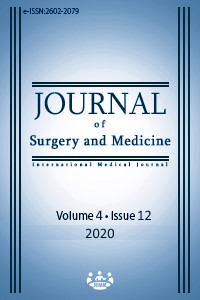Association of routine hematological and inflammation parameters with surgical treatment results in patients with carpal tunnel syndrome
Keywords:
C-reactive protein/albumin ratio, Surgical treatment, Carpal tunnel syndrome, Neutrophil/eosinophil ratio, Systemic inflammationAbstract
Aim: Neutrophil/lymphocyte ratio, neutrophil/eosinophil ratio (NER), and C-reactive protein-to-albumin ratio (CAR) reflect systemic inflammation. However, their relationship with the surgical treatment of carpal tunnel syndrome (CTS) has not been studied. In the present research, the association between systemic inflammation parameters and CTS surgical treatment results was investigated in patients with neurophysiologically moderate CTS. Methods: The present study was conducted retrospectively on patients who underwent surgical treatment owing to moderate CTS. The postoperative results were evaluated by a nerve conduction study (NCS) performed approximately 6 months after the surgery. Patients were divided into three groups based on the postoperative NCS: Patients who did not have CTS according to NCS were defined as “the group fully benefiting” from surgical treatment, patients with mild CTS were included in “the group partially benefiting,” from surgical treatment, and patients with moderate or severe CTS were included in “the group with no benefit.” Results: Forty-one patients with moderate CTS were included in the study. There was a significant difference between the groups in terms of median CAR, white blood cell, neutrophil, NER, and C-reactive protein (CRP) levels (P<0.001, P=0.012, P=0.014, P=0.005 and P=0.001, respectively). There was also a statistically significant and strong positive correlation among postoperative CTS severity, CAR (rho: 0.633, P<0.001) and CRP (rho: 0.603, P<0.001). Conclusion: In the current study, it was found that CTS patients with higher CAR levels achieved less benefit from the surgical treatment.
Downloads
References
Bland JD. Carpal tunnel syndrome. BMJ. 2007;335(7615):343-6. doi: 10.1136/bmj. 39282.623553.AD
Shi Q, MacDermid JC. Is surgical intervention more effective than non-surgical treatment for carpal tunnel syndrome? A systematic review. J Orthop Surg Res. 2011;6:17. doi: 10.1186/1749-799X-6-17.
Bland JD. Treatment of carpal tunnel syndrome. Muscle Nerve. 2007;36(2):167-71. doi: 10.1002/mus.20802
Campagna R, Pessis E, Feydy A, et al. MRI assessment of recurrent carpal tunnel syndrome after open surgical release of the median nerve. AJR Am J Roentgenol. 2009;193(3):644-50. doi: 10.2214/AJR.08.1433.
Mosier BA, Hughes TB. Recurrent carpal tunnel syndrome. Hand Clin. 2013;29(3):427-34. doi: 10.1016/j.hcl.2013.04.011.
Güneş M, Özeren E. Effect of age and body mass index on surgical treatment outcomes in patients with carpal tunnel syndrome. Turk Neurosurg. Published Online Oct 28, 2020. doi: 10.5137/1019-5149.JTN.29704-20.2
Bender M, Haferkorn K , Friedrich M, Uhl E, Stein M. Impact of Early C-Reactive Protein/Albumin Ratio on Intra-Hospital Mortality Among Patients With Spontaneous Intracerebral Hemorrhage. J Clin Med. 2020;9(4):1236. doi: 10.3390/jcm9041236.
Güneş M. Is neutrophil/eosinophil ratio at admission a prognostic marker for in-hospital mortality of acute ischemic stroke? J Stroke Cerebrovasc Dis. 2020 Aug;29(8):104999. doi: 10.1016/j.jstrokecerebrovasdis.2020.104999
Güneş M, Büyükgöl H. Correlation of neutrophil/lymphocyte and platelet/lymphocyte ratios with the severity of idiopathic carpal tunnel syndrome. Muscle Nerve. 2020;61:369–74. doi: 10.1002/mus.26791.
Özeren E, Güneş M. Do early neutrophil to eosinophil ratio and the levels of neutrophil and white blood cells predict intra-hospital mortality in patients with spontaneous intracerebral hemorrhages? J Surg Med. 2020;4(9):812-16.
Cohen J. Statistical Power Analysis for the Behavioral Sciences. Abington, UK: Routledge; 1988.
Emerging Risk Factors Collaboration; Kaptoge S, Di Angelantonio E, Lowe G, et al. C-reactive protein concentration and risk of coronary heart disease, stroke, and mortality: an individual participant meta-analysis. Lancet. 2010;375:132–40. doi: 10.1016/S0140-6736(09)61717-7.
Fest J, Ruiter R, Ikram MA, Voortman T, van Eijck CHJ, Stricker BH. Reference values for white blood-cell-based inflammatory markers in the Rotterdam Study: a population-based prospective cohort study. Sci Rep. 2018;8(1):10566. doi: 10.1038/s41598-018-28646-w.
Liu S, Liu X, Chen S, Xiao Y, Zhuang W. Neutrophil-lymphocyte Ratio Predicts the Outcome of Intracerebral Hemorrhage: A meta-analysis. Medicine (Baltimore). 2019;98(26):e16211. doi: 10.1097/MD.000000016211.
Demirdal T, Sen P. The significance of neutrophil-lymphocyte ratio, platelet-lymphocyte ratio and lymphocyte-monocyte ratio in predicting peripheral arterial disease, peripheral neuropathy, osteomyelitis and amputation in diabetic foot infection. Diabetes Res Clin Pract. 2018;144:118-25. doi: 10.1016/j.diabres.2018.08.009.
Tunç A. Early predictors of functional disability in Guillain-Barré Syndrome. Acta Neurol Belg. 2019;119(4):555-9. doi: 10.1007/s13760-019-01133-3.
Ozdemir HH. Analysis of the albumin level, neutrophil-lymphocyte ratio, and platelet-lymphocyte ratio in Guillain-Barre syndrome. Arq Neuropsiquiatr. 2016;74(9):718-22. doi: 10.1590/0004-282X20160132.
Huang Y, Ying Z, Quan W, et al. The clinical significance of neutrophil-to-lymphocyte ratio and monocyte-to-lymphocyte ratio in Guillain-Barre syndrome. Int J Neurosci. 2018;128(8):729-35. doi: 10.1080/00207454.2017.1418342.
Downloads
- 381 505
Published
Issue
Section
How to Cite
License
Copyright (c) 2020 Muzaffer Güneş
This work is licensed under a Creative Commons Attribution-NonCommercial-NoDerivatives 4.0 International License.
















